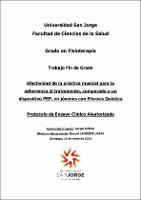Por favor, use este identificador para citar o enlazar este ítem:
https://repositorio.usj.es/handle/123456789/846
Registro completo de metadatos
| Campo DC | Valor | Lengua/Idioma |
|---|---|---|
| dc.contributor.advisor | Lafuente Ureta, Raquel | - |
| dc.contributor.author | Eymas, Maylis | - |
| dc.date.accessioned | 2022-09-12T12:50:49Z | - |
| dc.date.available | 2022-09-12T12:50:49Z | - |
| dc.date.issued | 2022-05-16 | - |
| dc.identifier.uri | https://repositorio.usj.es/handle/123456789/846 | - |
| dc.description | Background: Cystic fibrosis is an inherited pathology that can have a systemic spread, affecting mucus production. Its best-known expression is in the respiratory system, obstructing the airways and creating a breeding ground for infections. Treatment is usually important, with physiotherapy playing a major role. However, because of the investment it generates, there is a problem of adherence to treatment which can be detrimental to the patient, particularly in children. For this reason, specialists are trying to find treatment substitutes. One of them is music therapy. Objetive: To evaluate the efficacy of respiratory physiotherapy combined with music practice, compared to respiratory physiotherapy combined with the use of a PEP device, to improve adherence to treatment in young CF patients. Methodology: It will be a randomised clinical trial protocol. It will be conducted at the CRCM Pellegrin in Bordeaux. Each group will receive a daily session of 30 minutes of autogenous drainage. The control group will have 15 minutes of Threshold PEP while the intervention group will have 15 minutes of harmonic practice, both at home. Follow-up will be for 3 months. The primary variable will be adherence to treatment as measured by the Manchester Cystic Fibrosis Compliance Questionnaire, assessed at the beginning, middle and end of the follow-up period. The quantity of expectoration, respiratory functions with spirometry (FEV1, FVC, FEV1/FVC, FEF25-75%), respiratory muscle strength (PIM and PEM), quality of life (CFQ-R) and exercise tolerance (6MWT) will also be assessed as secondary variables. Expected results: We hope to demonstrate that the practice of music in young people with CF will significantly increase adherence to treatment. We also wish to demonstrate an increase in quality of life, as well as in muscle strength and respiratory function. The results will be less evident in terms of exercise tolerance and the amount of expectoration. This protocol will demonstrate that music practice can be a good alternative to CF treatment in clinical practice, applied among other more conventional devices. | es_ES |
| dc.description.abstract | Antecedentes: La fibrosis quística es una patología hereditaria que puede tener una expansión sistémica, afectando la producción de mucosa. Su expresión más conocida es sobre el sistema respiratorio, obstruyendo las vías aéreas y creando un terreno propicio a las infecciones. El tratamiento suele ser importante con gran importancia de la fisioterapia. No obstante, por la inversión que genera, existe un problema de adherencia al tratamiento que puede ser prejudicial al paciente, particularmente en niños. Por esa razón especialistas intentan encontrar sustitutos de tratamientos. Una de ellas es la musicoterapia. Objetivo: Evaluar la eficacia de la fisioterapia respiratoria combinada a la práctica musical, comparado a fisioterapia respiratoria combinada al empleo de un dispositivo PEP, para mejorar la adherencia al tratamiento en jóvenes pacientes con FQ. Metodología: Se tratará de un protocolo de ensayo clínico aleatorizado. Se llevará a cabo en el seno del CRCM Pellegrin de Burdeos. Cada grupo recibirá una sesión cotidiana de 30 min de drenaje autógeno. El grupo control tendrá 15min de Threshold PEP mientras el grupo intervención tendrá 15min de práctica de la armónica, ambos en casa. Se realizará un seguimiento de 3 meses. La variable primaria será la adherencia al tratamiento medida mediante el Manchester Cystic Fibrosis Compliance Questionnaire, valorada al principio, en medio y al final del periodo de seguimiento. También se valorará como segundarias la cantidad de expectoración, las funciones respiratorias con espirometría (FEV1, FVC, FEV1/FVC, FEF25-75%), la fuerza de los músculos respiratorios (PIM y PEM), la calidad de vida (CFQ-R) y la tolerancia al ejercicio (6MWT). Resultados esperados: Se esperará demostrar que la práctica musical en jóvenes con FQ permitirá aumentar de manera significativa la adherencia al tratamiento. También se deseará demostrar un aumento de la calidad de vida, así que de la fuerza muscular y de las funciones respiratorias. Los resultados serán menos evidentes acerca de la tolerancia al ejercicio y de la cantidad de expectoración. Este protocolo querrá poner en evidencia que la práctica musical puede ser una buena alternativa al tratamiento de la FQ en la práctica clínica, aplicada entre otros dispositivos más convencionales. | es_ES |
| dc.format.extent | 41 p. | es_ES |
| dc.format.mimetype | application/pdf | es_ES |
| dc.language.iso | spa | es_ES |
| dc.relation.requires | adobe/ PDF | es_ES |
| dc.rights | Attribution-NonCommercial-NoDerivatives 4.0 Internacional | * |
| dc.rights.uri | http://creativecommons.org/licenses/by-nc-nd/4.0/ | * |
| dc.subject | Fibrosis quística | es_ES |
| dc.subject | fisioterapia respiratoria | es_ES |
| dc.subject | musicoterapia activa | es_ES |
| dc.subject | , adherencia al tratamiento | es_ES |
| dc.title | Efectividad de la práctica musical para la adherencia al tratamiento, comparado a un dispositivo PEP, en jóvenes con Fibrosis Quística | es_ES |
| dc.type | info:eu-repo/semantics/bachelorThesis | es_ES |
| dc.rights.accessrights | info:eu-repo/semantics/openAccess | es_ES |
| dc.contributor.affiliation | Universidad San Jorge | es_ES |
| Aparece en las colecciones: | Grado en Fisioterapia | |
Ficheros en este ítem:
| Fichero | Descripción | Tamaño | Formato | |
|---|---|---|---|---|
| Efectividad de la práctica musical.pdf | 1,12 MB | Adobe PDF |  Visualizar/Abrir |
Este ítem está sujeto a una licencia Creative Commons Licencia Creative Commons

